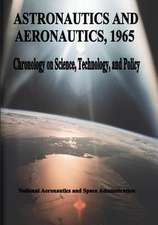Astronautics and Aeronautics, 1971
Autor National Aeronautics and Administrationen Limba Engleză Paperback
Preț: 192.26 lei
Nou
Puncte Express: 288
Preț estimativ în valută:
36.79€ • 38.41$ • 30.38£
36.79€ • 38.41$ • 30.38£
Carte tipărită la comandă
Livrare economică 16-30 aprilie
Preluare comenzi: 021 569.72.76
Specificații
ISBN-13: 9781495485213
ISBN-10: 1495485218
Pagini: 488
Dimensiuni: 178 x 254 x 25 mm
Greutate: 0.84 kg
Editura: CREATESPACE
ISBN-10: 1495485218
Pagini: 488
Dimensiuni: 178 x 254 x 25 mm
Greutate: 0.84 kg
Editura: CREATESPACE






















